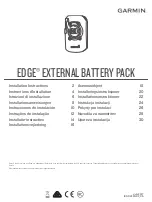
Note:
If no battery is connected, the digital display will show “– – –“; if connecting
to an inapplicable battery (e.g. 24V battery), the digital display will show “Er1”; if
connecting to a dead battery, the digital display will show “Er2”.
Battery Type Button
– Select the appropriate setting for the type of battery you are
charging. Most automotive batteries are standard batteries. If unsure of the type of
battery being charged, refer to the battery manufacturer for more information.
Charging and Charged LED Indicators
– When the battery charger is charging the
battery, the charging LED will be on. When the battery has reached a full charge, the
charging LED will go off, and the Charged LED will be on, indicating the battery is fully
charged.
Reverse LED Indicator
– The red LED will light when the Battery Charger is not properly
connected to the battery. When lit, it will not allow the Battery Charger to begin charging.
This feature will only work on batteries that have at least 1 volt of charge.
Circuit Breaker
This Battery Charger has an internal, self-resetting circuit breaker that protects the
Battery Charger from temporary overloads. When it operates, it makes a clicking sound
and the current will be cutoff. After a cool-down period, the breaker will automatically
close and the current will recover automatically. If the breaker continues to cycle every
few minutes, reduce charge rate or discontinue charging.
Before Charging
• Make sure the Battery Charger is disconnected from the power supply.
• Make sure that the voltage of the battery matches the rated output of the Battery
Charger by referring to the vehicle owner’s manual.
• Check the polarities of the battery terminals: positive for the (+) symbol and negative
for the (–) symbol.
Pre-Charge Activation
When starting to charge a battery, the current will depend on the battery’s percent of
charge. The actual current will usually be lower than the current selected on the Battery
Charger, unless the battery is severely discharged. As the battery charge level increases,
the current reduces. The digital meter is intended to show how the charging process is
proceeding; it should not be used to determine the level of battery charge accurately - this
should be done using a hydrometer or a voltmeter. Typically, 12.6V DC is considered full
charge for a 12-volt battery if the voltage is measured one hour after the Battery Charger
is disconnected. During charging, a nominal 12-volt battery can be 13.6 volts or higher,
so it needs to rest after charging to measure state of charge.
EXPLOSION HAZARD
Be aware that a fully charged battery will also cause a low current reading.
Attempting pre-charge activation of a fully charged battery may cause explosion -
make sure that battery is discharged before using this procedure. Pre-charge
activation is the term for the time it takes before a battery begins to accept a
measurable rate of charge - it can be as long as 4-8 hours from the time the
charging process begins. Pre-charge activation is indicated if the ammeter reading
is zero and a hydrometer or voltmeter reading shows that the battery is fully
discharged.























